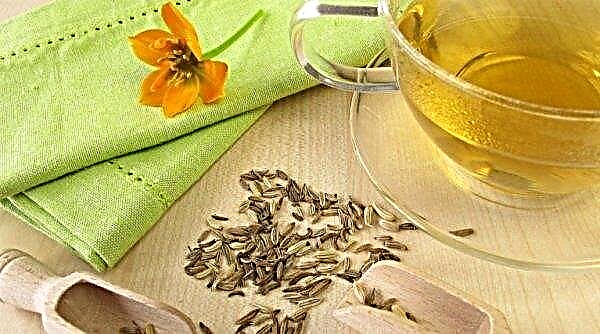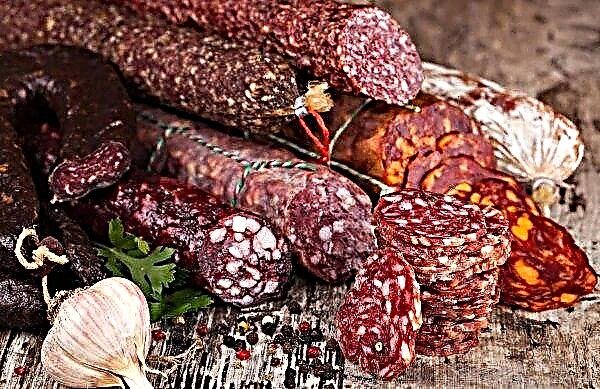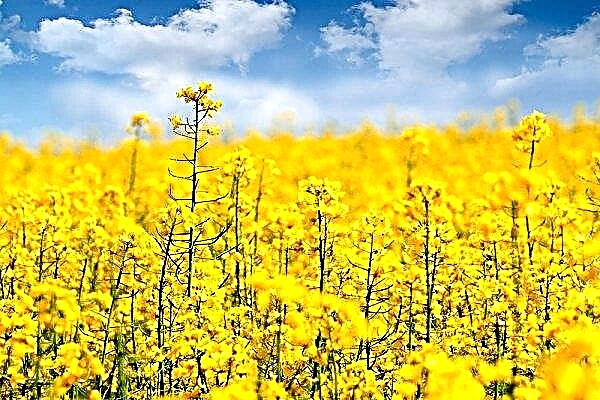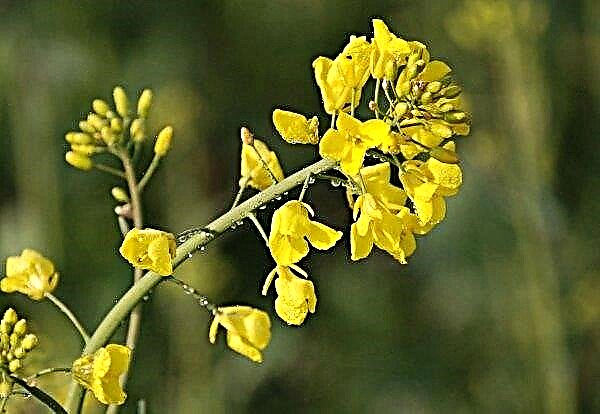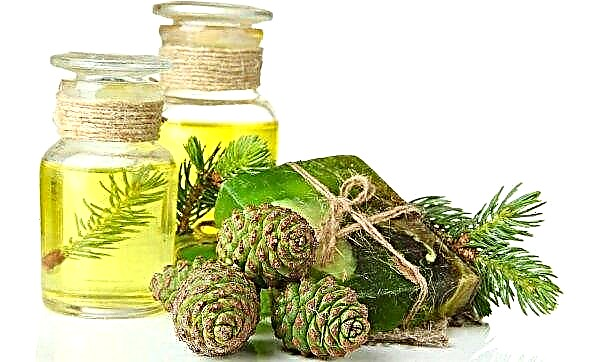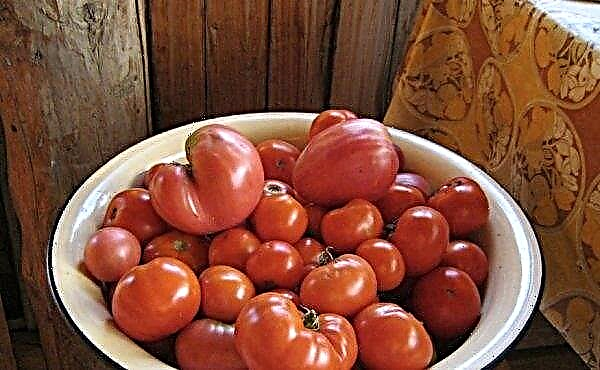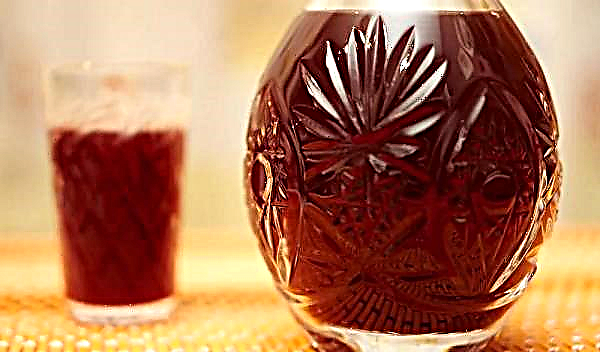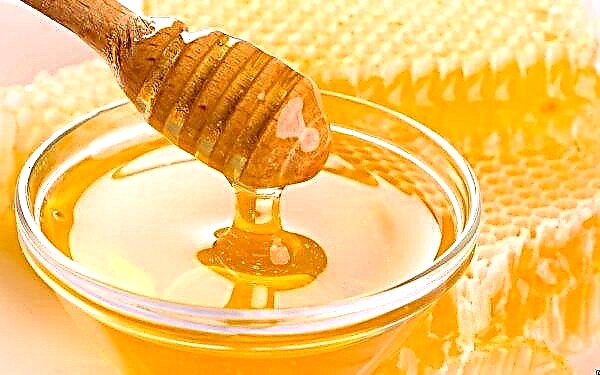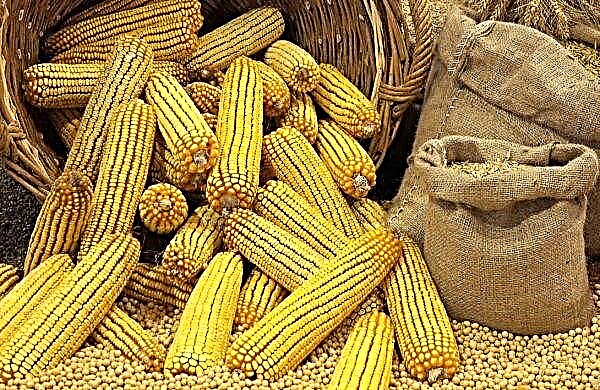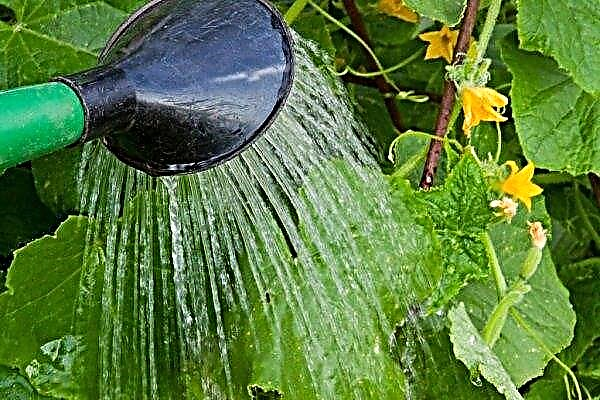Pakhira aquatica or Malabar chestnut is an evergreen tree with a dense rounded crown. Its edible seeds can be eaten, used in the pharmaceutical industry, in the manufacture of dyes and environmentally friendly pillows. The article will focus on growing this tree at home.
Botanical description of the plant
Pachira was discovered in the tropical forests of Guyana in 1775 by the French botanist Jean Aublé, and in 1782, independently of it, by Karl Linnaeus. His name was assigned to the tree as a scientific one. The name itself comes from the language spoken in Guyana. The name of the species in Latin means water.
The plant has many synonymous names: Malabar chestnut, French peanuts, Guian chestnut, provision, saba nut, monguba, pumpo. On sale found under the name "money tree".
Did you know? In nature, pakhira flowers pollinate bats.
In the wild grows in South America - Brazil, Bolivia, Peru, Ecuador, Colombia, Venezuela, Guyana; North America - in Panama and Mexico. It grows well on clay banks of rivers and marshy areas. Its seeds fall into the water and can swim for several months without losing germination to new habitats. They will sprout only when they land.
Its seeds fall into the water and can swim for several months without losing germination to new habitats. They will sprout only when they land.
Pakhira aquatica (aquatic pahira) grows up to 6-14 meters in height. In cold climatic zones it is grown as a house tree. A straight cylindrical trunk reaches a diameter of 30–40 cm. It looks like a bundle of twisted stems. Inside the trunk contains water, which allows you to tolerate dry periods. The plant is considered a succulent.
Pakhira has green palm-shaped lanceolate leaves. Due to its interesting plant shape and decorative flowers, pachira grows as a decorative element in gardens and parks of tropical countries, where it can reach a height of 23 m. The plant adapts well to various weather conditions.
Its spectacular vibrant flowers unfold like a banana peel. They have an intense vanilla flavor. They can be of different colors - from white to cream. Flowering continues from June to November. The tree is grown because of its edible nuts. They look like chestnuts. Located in a large rounded pod.
Conditions for growing at home
A tropical plant is capable of tolerating a wide range of temperatures and humidity. In the park zone, it can grow on loamy soils, in areas with bright lighting or alternating light. Being a succulent, pahira is resistant to drought.
In indoor plant growing in the form of a bonsai or just like a potted plant. Malabar chestnut does not have frost resistance, therefore, in the CIS regions it can be grown only indoors.
What kind of lighting is needed for the plant
The plant does not need direct sunlight, although in bright light it looks much better. An eastern or western window and variable lighting throughout the day are suitable for installing a container with pahira.
Since the tree grows in the direction of the light, you should turn it from time to time to avoid asymmetries in its development. Office plants grow beautifully in fluorescent light.
Important! Avoid changing the location of the tree often, because it may fall leaves.
Requirements for temperature and humidity
The optimum air temperature is +16 ... + 18 ° С, humidity - 60–70%. In winter, the temperature can be lower (+15 ... + 16 ° С), since the plant is in a dormant period, and from the beginning of the growing season it is set not lower than + 18 ° С.
If the air in your house is dry, especially in winter, increase the humidity by placing the pot on a tray with gravel and water.
Features of home care
Home care consists of:
- periodic watering;
- fertilizer application;
- climate control.
Periodic care measures include trimming the crown to lower its height and shape its appearance, as well as fighting diseases or pests.
Watering Rules
Most plants are extremely dependent on watering, as they are all made up of water. But succulents do not require emergency measures. They only need one watering a week from spring to autumn. Water the plants until the water comes out of the drainage holes.
Then let it dry until the next watering. If there is insufficient moisture, then the elasticity of the leaves decreases, and if there is an excess, then the roots rot.
Water is maintained for irrigation or rainwater is used. Water temperature - room temperature (+ 20 ° С). Do not soak the stems during watering to avoid decay. Also, the plant should not stagnate in water so that root decay does not begin. In winter, growth slows down. Reduce the amount of water that you give the plant during this period.
Did you know? For the first time, pakhira aquatic can bloom only 5 years after planting.
Top dressing
The indoor version of pakhira needs to be fed only 2-3 times a year. Use balanced fertilizer to ensure optimal nutrition. You can also feed every 2 weeks from spring to summer if you think the plant looks weak.
It is preferable to use liquid fertilizers, but root dressing with granular fertilizers can also be carried out. Excess fertilizer harms the plant. It can begin to grow in height without the full development of the crown.
Pruning
For indoor plants, pruning is done to maintain the shape of the crown. In this case, the leaves are cut just below the sinus. Cut off those leaves that are very elongated. This helps to form a dense crown, since at the place of the cut branching occurs on 2 branches.
Krone try to give the shape of a ball. The best time to trim is spring.
If there are no elongated leaves and you are satisfied with the shape of the crown, then pruning is not carried out. The exception is situations when you see diseased or damaged leaves or branches.
Did you know? Pahira water — it is almost the only symbol that in feng shui means wood, water, fire, earth and metal at the same time.
Transfer
The purpose of the transplant is soil renewal. The plant does not like this process, therefore they perform it no more than 1 time in 2 years and only when the root system is closely in the container. The first transplant can take place when you bring the plant from the store.
Pahira. Transplant: video
Usually it is sold in small pots, and this prevents it from growing normally. The pot should be 2–4 cm larger in diameter than the root system of the plant.
The best time for transplanting is spring. When transplanting, remove all dry or dead roots. If any leaves fall, then this is normal and should not bother you.
Step-by-step instruction:
- Prepare a new pot and soil mixture. It can be compost mixed in equal proportions with garden soil and sand. But you can buy palm soil in the store. It is also suitable for this purpose.
- To make it convenient to take out the plant, abundantly water the earthen lump.
- Carefully remove it by tapping the walls of the pot.
- Place drainage at the bottom of the new pot. It can be pebbles, ceramic shards. It should take ¼ part of the pot.
- Pour the prepared mixture.
- Set the plant there and add the mixture. The plant must be covered with soil to the same height to which it was covered in the previous pot.
- Moisten the soil.
How to propagate at home
Malabar chestnut propagates in two ways: by cuttings and seeds. Cuttings are made from lateral shoots in the summer. Put them in pots and root. When propagated by seeds, they are germinated, and then the seedlings are planted in separate pots.
Did you know? Most Malabar chestnuts have five or six leaves on each stem. But sometimes there are those on which there are seven leaves on the stem. According to legend, such a tree brings good luck.
Cuttings
The most common breeding technique is to cut the stem. The optimal time is summer. Instructions for propagation by cuttings:
Instructions for propagation by cuttings:
- Cut a branch 10-15 cm long.
- Put it in water to sprout the roots.
- Place a container of water on the illuminated windowsill. This will accelerate root formation.
- Treat the roots with a growth stimulant.
- Prepare a container for rooting. It can be a relatively small pot.
- Prepare the soil from a mixture of sand and sphagnum moss.
- Pit and plant the stalk. This must be done so as not to damage the roots.
- Water abundantly.
- Compact the soil around the trunk.
- Place the pot on a windowsill with good lighting and an air temperature of +21 ... + 25 ° С.
Did you know? Under natural conditions, the pachira trunk does not braid on its own. This feature of appearance is formed by the one who grows this unique plant.
Seeds
Propagation by seeds is less common, but it is simpler than grafting. Step-by-step instructions for propagating by seeds:
Step-by-step instructions for propagating by seeds:
- Start by soaking the seeds in water for 24 hours.
- Prepare the substrate from the leafy soil and evenly distribute the seeds in it.
- Cover them with approximately 1 cm of soil.
- Water abundantly.
- Place in a bright and warm place.
- Shoots should appear 3 weeks after planting.
Throughout the germination period, water at regular intervals. And when the plants become large enough, place them in separate pots.
Important! The tree can grow unusually high — up to 23 m. To reduce its height for the room, twist the trunk.
Growing difficulties
Trees that are grown indoors, practically do not encounter pests and rarely get sick. But some problems may still occur.
Among the diseases are:
- withering leaves. It arises and develops due to low humidity or insufficient amount of fertilizer. Check the humidity and fertilize the plant with fertilizer with an increased dose of potassium;
- spots on the leaves also cause a lack of potassium. It is treated with potash fertilizers;
- Pale spots may occur due to excessive watering. Adjust the schedule and remember that the soil should dry out between waterings. Also remove all dead leaves to stop the spread of the disease;
- rotting of the roots and mold occur due to excessive watering. Change the schedule and transplant the plant into fresh and well-drained soil. Remove any dead roots in the process.
 Waterborne pachyra pests can occur if you take the pots outside in the summer.
Waterborne pachyra pests can occur if you take the pots outside in the summer.Among the main pests:
- aphid - These are small green insects up to 1 mm long. They feed on the sap of plants and form colonies, clinging to the stem. They are destroyed by spraying with a solution of insecticidal soap;
- spider mites almost invisible to the naked eye. Their presence is manifested by white cobwebs, dark spots on leaves that turn black and dry. They appear if the weather is dry and hot. For treatment, wash the plant and increase humidity to fix the problem.
Growing indoor trees is a snap. High decorative properties and ease of care make Malabar chestnut (pahira) acceptable for landscaping recreation areas of office centers, restaurants and any large rooms.

